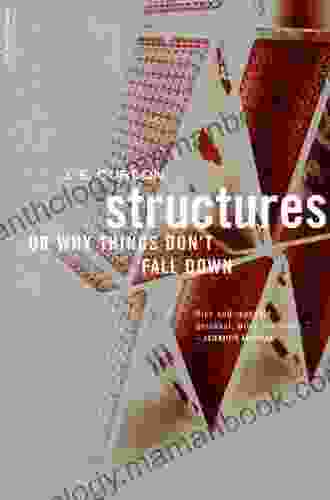Structures: Delving into the Art and Science of Why Things Don't Fall Down

From towering skyscrapers to delicate bridges, structures of all shapes and sizes dominate our built environment. They provide shelter, facilitate commerce, and connect communities. Yet, despite their ubiquitous presence, understanding what makes a structure stand tall is a fascinating scientific and engineering pursuit that has intrigued thinkers for centuries. In this article, we delve into the intricate world of structures, exploring the fundamental principles that govern their behavior and ensure their resilience against the forces of nature.
The Physics of Stability
The stability of a structure hinges upon its ability to withstand external forces without collapsing or undergoing excessive deformation. These forces can include gravity, wind, earthquakes, and even human activity. To understand how structures resist these forces, we must examine the physical principles at play.
4.7 out of 5
| Language | : | English |
| File size | : | 22788 KB |
| Text-to-Speech | : | Enabled |
| Screen Reader | : | Supported |
| Enhanced typesetting | : | Enabled |
| Word Wise | : | Enabled |
| Print length | : | 520 pages |
Gravity: The Downward Pull
Gravity is the primary force that draws objects towards the Earth's center. In the context of structures, gravity exerts a downward force that seeks to pull buildings down. To counteract this force, structures must be designed with sufficient weight and strength to resist being crushed by their own weight.
Equilibrium: A Balance of Forces
Stability is achieved when the forces acting on a structure are balanced. This state of equilibrium is crucial because it prevents the structure from toppling over or collapsing. Engineers carefully calculate the distribution of weight, the placement of supports, and the resistance of materials to ensure that structures remain in a state of equilibrium, even under various external loads.
Structural Integrity: Strength and Resilience
Structural integrity refers to a structure's ability to withstand forces without breaking or deforming excessively. The materials used in construction, the design of structural elements, and the quality of workmanship all contribute to a structure's integrity. By using strong and durable materials, engineers can create structures that can endure the stresses and strains of everyday use and environmental conditions.
Engineering Concepts: From Theory to Application
Engineering plays a pivotal role in designing and constructing structures that are both safe and aesthetically pleasing. Engineers employ various concepts and techniques to ensure structural stability and integrity.
Load Analysis: Predicting Forces Acting on Structures
Load analysis is a crucial step in structural design. It involves calculating the various forces that a structure will encounter throughout its lifetime. Engineers consider factors such as dead loads (the weight of the structure itself),live loads (occupants and furniture),wind loads, and seismic loads. By accurately predicting these forces, engineers can design structures that can withstand them without failure.
Strength of Materials: Understanding the Behavior of Building Blocks
The strength of materials is a fundamental aspect of structural engineering. Engineers need to understand how different materials behave under stress and strain to select the most appropriate materials for each structural element. Materials such as steel, concrete, and wood have distinct properties that determine their suitability for specific parts of a structure.
Structural Design: Translating Theory into Practice
Structural design is the art of applying engineering principles to create structures that meet specific requirements and performance criteria. Engineers must consider factors such as aesthetics, functionality, cost, and environmental impact in their designs. Through careful planning and analysis, they determine the geometry, dimensions, and materials to be used in a particular structure.
Historical Perspectives: Lessons from the Past
Throughout history, civilizations have experimented with various structural forms and materials to create awe-inspiring architectural wonders. These historical structures provide valuable insights into the evolution of structural engineering and the enduring principles that have guided builders for centuries.
Ancient Pyramids: Monuments to Monumental Stability
The pyramids of Giza, built over 4,500 years ago, stand as testaments to the ingenuity and skill of ancient Egyptian engineers. Their colossal size and geometric precision showcase the understanding of gravity, equilibrium, and load distribution that existed even in ancient times.
Gothic Cathedrals: Soaring Structures of Light and Grace
Gothic cathedrals, constructed during the Middle Ages, exemplify the interplay between structural integrity and architectural beauty. Their soaring spires and intricate vaults demonstrate the mastery of structural design, with elements such as flying buttresses and ribbed vaults used to distribute weight and resist wind loads.
Modern Skyscrapers: Pushing the Boundaries of Height and Strength
The development of steel and reinforced concrete in the 19th and 20th centuries revolutionized structural engineering, enabling the construction of skyscrapers that reach unprecedented heights. Engineers have continuously pushed the boundaries of structural design to create these towering structures that redefine the urban landscape.
Contemporary Challenges: Sustainability and Resilience
In the modern era, structural engineering faces new challenges related to sustainability and resilience. Engineers are seeking innovative ways to reduce the environmental impact of structures and improve their ability to withstand natural disasters.
Sustainable Structures: Minimizing Environmental Footprint
Sustainability has become a pressing concern in structural design. Engineers are exploring environmentally friendly materials, such as recycled steel and bamboo, to reduce the carbon footprint of structures. They are also incorporating energy-efficient features to minimize energy consumption during operation.
Resilient Structures: Withstanding Natural Disasters
Natural disasters, such as earthquakes, hurricanes, and floods, can pose significant threats to structures. Engineers are developing innovative structural designs, such as base isolation systems and seismic dampers, to enhance the resilience of structures and protect them from damage during these events.
Structures are not merely static objects; they are dynamic entities that interact with their surroundings and bear witness to the ingenuity and perseverance of human endeavor. Understanding the principles that govern the stability and integrity of structures is not only a testament to human knowledge but also a source of inspiration for future architectural and engineering marvels. As we continue to push the boundaries of structural design, we can create structures that are not only aesthetically pleasing but also safe, sustainable, and resilient, shaping the built environment for generations to come.
4.7 out of 5
| Language | : | English |
| File size | : | 22788 KB |
| Text-to-Speech | : | Enabled |
| Screen Reader | : | Supported |
| Enhanced typesetting | : | Enabled |
| Word Wise | : | Enabled |
| Print length | : | 520 pages |
Do you want to contribute by writing guest posts on this blog?
Please contact us and send us a resume of previous articles that you have written.
 Top Book
Top Book Novel
Novel Fiction
Fiction Nonfiction
Nonfiction Literature
Literature Paperback
Paperback Hardcover
Hardcover E-book
E-book Audiobook
Audiobook Bestseller
Bestseller Classic
Classic Mystery
Mystery Thriller
Thriller Romance
Romance Fantasy
Fantasy Science Fiction
Science Fiction Biography
Biography Memoir
Memoir Autobiography
Autobiography Poetry
Poetry Drama
Drama Historical Fiction
Historical Fiction Self-help
Self-help Young Adult
Young Adult Childrens Books
Childrens Books Graphic Novel
Graphic Novel Anthology
Anthology Series
Series Encyclopedia
Encyclopedia Reference
Reference Guidebook
Guidebook Textbook
Textbook Workbook
Workbook Journal
Journal Diary
Diary Manuscript
Manuscript Folio
Folio Pulp Fiction
Pulp Fiction Short Stories
Short Stories Fairy Tales
Fairy Tales Fables
Fables Mythology
Mythology Philosophy
Philosophy Religion
Religion Spirituality
Spirituality Essays
Essays Critique
Critique Commentary
Commentary Glossary
Glossary Bibliography
Bibliography Index
Index Table of Contents
Table of Contents Preface
Preface Introduction
Introduction Foreword
Foreword Afterword
Afterword Appendices
Appendices Annotations
Annotations Footnotes
Footnotes Epilogue
Epilogue Prologue
Prologue Christo Sullivan
Christo Sullivan Sergei Guriev
Sergei Guriev Pere Gimferrer
Pere Gimferrer Kristi Bradley
Kristi Bradley P M Forni
P M Forni J J Murphy
J J Murphy Cindy Stringer Wismer
Cindy Stringer Wismer Jennifer Lynn Barnes
Jennifer Lynn Barnes Alice Waters
Alice Waters Hayden Thorne
Hayden Thorne Susan D Fay
Susan D Fay Keith Hosman
Keith Hosman Earl B Mcelfresh
Earl B Mcelfresh Stephen Graham Jones
Stephen Graham Jones Thomas Sowell
Thomas Sowell Fumiaki Shingu
Fumiaki Shingu Susan Perry
Susan Perry Francisco De Rojas Zorrilla
Francisco De Rojas Zorrilla Jess Kidd
Jess Kidd Maia Kobabe
Maia Kobabe
Light bulbAdvertise smarter! Our strategic ad space ensures maximum exposure. Reserve your spot today!

 Neil ParkerUnveiling the Enchanting World of Impromptu Music for Flute, Oboe, Clarinet,...
Neil ParkerUnveiling the Enchanting World of Impromptu Music for Flute, Oboe, Clarinet,...
 Roland HayesEmbrace the Magic: Favorite Disney Songs for Clarinet Instrumental Play Along
Roland HayesEmbrace the Magic: Favorite Disney Songs for Clarinet Instrumental Play Along Gerald BellFollow ·11.6k
Gerald BellFollow ·11.6k Pete BlairFollow ·15.6k
Pete BlairFollow ·15.6k Gage HayesFollow ·7.9k
Gage HayesFollow ·7.9k Cristian CoxFollow ·4.3k
Cristian CoxFollow ·4.3k Angelo WardFollow ·7.2k
Angelo WardFollow ·7.2k Bradley DixonFollow ·6.7k
Bradley DixonFollow ·6.7k Gregory WoodsFollow ·12.7k
Gregory WoodsFollow ·12.7k Don ColemanFollow ·8.1k
Don ColemanFollow ·8.1k

 Vernon Blair
Vernon BlairThe Woman I Met in My Dream: An Unforgettable Night of...
As the veil of night...

 Carlos Fuentes
Carlos FuentesThe Ultimate Guide to Healthy Eating for Toddlers: Meal...
As a parent of a...

 Peter Carter
Peter CarterInside My Autistic Mind: A Journey of Self-Discovery and...
Autism spectrum disorder (ASD) is a...

 Isaac Asimov
Isaac AsimovA Journey Through Jane Austen's Literary Masterpieces:...
Jane Austen, the renowned English...

 Hank Mitchell
Hank MitchellAdvancements in Textiles: Science and Technology by...
The textile...

 Troy Simmons
Troy SimmonsRecovery Road: An Odyssey of Hope and Redemption by...
Recovery Road is a...
4.7 out of 5
| Language | : | English |
| File size | : | 22788 KB |
| Text-to-Speech | : | Enabled |
| Screen Reader | : | Supported |
| Enhanced typesetting | : | Enabled |
| Word Wise | : | Enabled |
| Print length | : | 520 pages |








